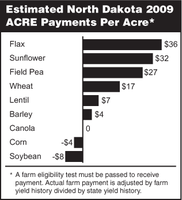Estimates Indicate ACRE Payments for 2009 in N.D. as Deadline Approaches
(Click the image below to view a high-resolution image that can be downloaded)
The new Average Crop Revenue Election (ACRE) program has been discussed for several months, but now is the time for farmers to make a decision if they want to participate this year.
The ACRE program is an optional program that replaces the counter-cyclical payment portion of the Direct and Counter-Cyclical Payment program and reduces direct payments by 20 percent and loan rates by 30 percent. Producers must complete the enrollment process, including all signatures of landowners, by the Aug. 14 deadline.
“The ACRE program provides payments to farm operators when the average revenue for this year’s crop falls below the benchmark revenue for that crop,” says Dwight Aakre, North Dakota State University Extension Service farm management specialist. “The revenue calculation is based on the average state yield and the national average marketing year price for each crop. The benchmark revenue is the average of the 2007 and 2008 crop year prices times the Olympic average of the 2004 through 2008 state average yields times 90 percent. The average market prices for most crops for 2007 and 2008 are the highest in history and therefore contribute to setting favorably high state benchmark revenues for most crops.”
This is still early in the year to have good estimates of state yields in this part of the country. However, considerable information is available regarding price outlook. Recent market action and the latest forecasts from the U.S. Department of Agriculture point to considerably lower prices for the 2009 crop. Using the latest USDA price forecasts and average state yield projections, ACRE payments may be available for many of the region’s crops.
“Flax, sunflowers and field peas look like the most likely to earn a significant ACRE payment,” says Andy Swenson, NDSU Extension farm management specialist. “Wheat, the No. 1 crop in North Dakota, also appears likely to earn an ACRE payment. The latest forecast from the USDA is for a national average market price of $5.30 for all wheat. This compares with the two-year price used to compute the benchmark revenue of $6.63 for a 20 percent decline. Since the revenue benchmark is 90 percent of a normal revenue based on recent yield and price history, a 10 percent decline in any combination of price and yield is the point at which an ACRE payment begins to accrue.”
Canola, corn and soybeans would trigger ACRE payments if actual revenue ends up slightly lower than currently projected. For example, projected revenue per acre of corn in 2009 is $439 per acre, assuming an average state yield of 117 bushels and an estimated national price of 3.75 per bushel. This revenue projection is only $8 too high to trigger an ACRE payment. Projected soybean revenue is within $4 of triggering an ACRE payment.
“Producers should seriously consider enrolling in the ACRE program in light of the weaker market outlook for the 2009 crop that has developed this summer,” Aakre says. “It is very possible that ACRE payments for the 2009 crop will be more than enough to make up for the reduction in direct payments for the next four years.”
An ACRE analyzer for North Dakota and Minnesota is available on the Web at http://www.ag.ndsu.nodak.edu/aginfo/farmmgmt/farmmgmt.htm to help producers evaluate whether to sign up for the program.
Information regarding ACRE can be found on the USDA’s Web site at http://www.fsa.usda.gov/dcp.
NDSU Agriculture Communication
| Source: | Dwight Aakre, (701) 231-7378, dwight.aakre@ndsu.edu |
|---|---|
| Source: | Andrew Swenson, (701) 231-7379, andrew.swenson@ndsu.edu |
| Editor: | Rich Mattern, (701) 231-6136, richard.mattern@ndsu.edu |


